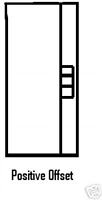HRE Monoblok 43 Design
#61
I don't think this makes sense. They would have to add material in the hub to achieve a more positive offset; subtract material to make a less positive offset.
Positive is out and away from the center line of the bearing; negative is in and away from the bearing centerline towards the vehicle's center line.
Correct?
Positive is out and away from the center line of the bearing; negative is in and away from the bearing centerline towards the vehicle's center line.
Correct?
#62
I don't think this makes sense. They would have to add material in the hub to achieve a more positive offset; subtract material to make a less positive offset.
Positive is out and away from the center line of the bearing; negative is in and away from the bearing centerline towards the vehicle's center line.
Correct?
Positive is out and away from the center line of the bearing; negative is in and away from the bearing centerline towards the vehicle's center line.
Correct?
HRE Monoblok wheels are not exactly lightweight. The P40 in 19x8.5 weighs 21.6 lbs. The 19x11 weighs about 24.9 lbs.
#63
If you reduce material from the mounting face of the wheel it brings the wheel "in" closer to the the centerline of the car. That's a negative offset.
#64
No. Adding material to a back pad pushes the wheel outward from the centerline of the vehicle, making the offset more negative. Removing material tucks the wheel further under the vehicle, making the offset more positive.
HRE Monoblok wheels are not exactly lightweight. The P40 in 19x8.5 weighs 21.6 lbs. The 19x11 weighs about 24.9 lbs.
HRE Monoblok wheels are not exactly lightweight. The P40 in 19x8.5 weighs 21.6 lbs. The 19x11 weighs about 24.9 lbs.
#65
If you remove material from the back pad of a wheel you increase the distance from the centerline to the backpad.
#66
I hope that explains it better.
#67
IMO, at under 20 lbs for the front wheel, the Champion and Dymag wheels better deserve the moniker.
#69
You win.
#70
Is this not correct?



Offsets:
There are three basic offsets, Negative offset, positive offset, and zero offset. Negative offset is the when the mounting surface is closer to the center of the car compared to the wheel centerline. Positive offset is the opposite, and refers to when the mounting surface of the wheel is farther away from the car than the wheel's centerline. Zero offset refers to a wheel that is neither positive or negative offset. The mounting surface is centered in the wheel.
There are three basic offsets, Negative offset, positive offset, and zero offset. Negative offset is the when the mounting surface is closer to the center of the car compared to the wheel centerline. Positive offset is the opposite, and refers to when the mounting surface of the wheel is farther away from the car than the wheel's centerline. Zero offset refers to a wheel that is neither positive or negative offset. The mounting surface is centered in the wheel.
#71
Is this not correct?



Offsets:
There are three basic offsets, Negative offset, positive offset, and zero offset. Negative offset is the when the mounting surface is closer to the center of the car compared to the wheel centerline. Positive offset is the opposite, and refers to when the mounting surface of the wheel is farther away from the car than the wheel's centerline. Zero offset refers to a wheel that is neither positive or negative offset. The mounting surface is centered in the wheel.
There are three basic offsets, Negative offset, positive offset, and zero offset. Negative offset is the when the mounting surface is closer to the center of the car compared to the wheel centerline. Positive offset is the opposite, and refers to when the mounting surface of the wheel is farther away from the car than the wheel's centerline. Zero offset refers to a wheel that is neither positive or negative offset. The mounting surface is centered in the wheel.
#72
http://www.tirerack.com/wheels/tech/...jsp?techid=101
#75
So then as to my original proposition, if a wheel maker removes material from the back of the wheel, it moves in a negative direction=negative offset.
So to get a positive offset two things would have to occur:
a) the rear forging would have to be quite deep (thick) to be machine removed to the desired offset
b) or material would have to be added such as in a spacer.
Thus, the wheel would have to be forged to have enough material to allow its offset to be changed by machining.




